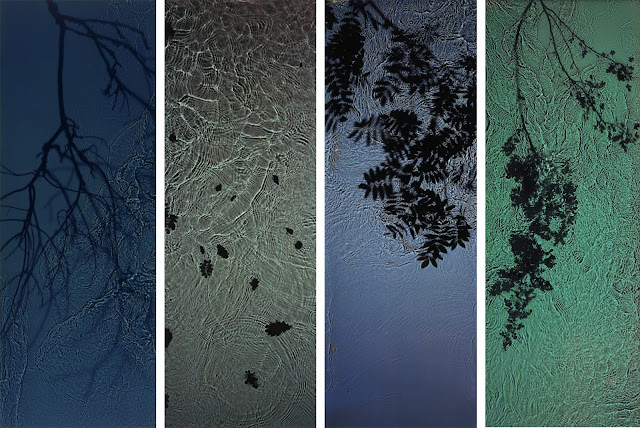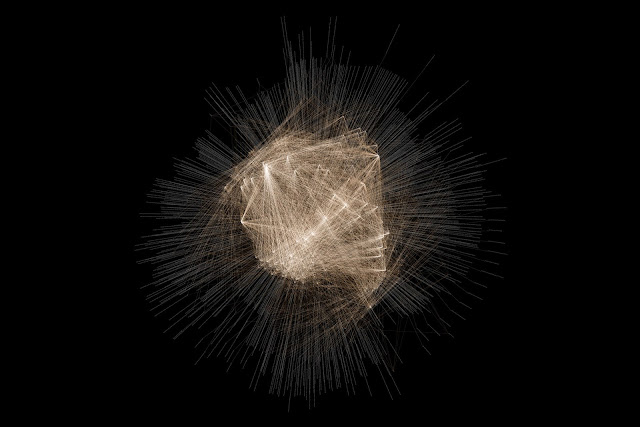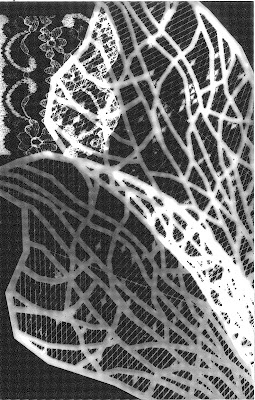The first images ever made were created without the use of camera. "For more than a century and until comparatively recently, photographs were captured through chemical reactions on light-sensitve emulsions on a glass plates or photographic film."(Appleyard, 2012, p. 423) So image can me created just having a photographic paper and light. One of the most common camera-less photography techniques is photogram. I had an opportunity to try it as well. In one of Johns workshops we were introduced to a darkroom and tried to do some photograms. This is what I got:
I used my headphones, keys, some materials and wooden wings that I borrowed from 3D workshops.
One more of camera-less photography works that I find interesting was created by Susan Derges. She uses night landscape as her darkroom, putting large sheets of photographic paper in rivers and using the moon and flashlight to create an exposure. She captures wave patterns, branches, sand and leaves and everything that is in the river onto paper. "The photographic metaphor has a deeper resonance with the character of water, as the liquid becomes the transparency that holds the record of its sensitive momentum."(Charlotte Cotton, 2010) Susan Derges records the flow of the water at night. She says that wave patterns carried downstream are like memory traces of past events. due to the fact that she doesn't use camera, the images are closer to the nature, to the thing that is being captured. Maybe that is why the images has something magical, dreamy to them.
Moreover, in these days photographs can be created even without the use of camera, photographic paper or light. Digital photography changed the way we create images. As I mentioned earlier in my blog images composed on a computer can still be called photographs. Photography captures the event or object that existed. There are many more ways how to save a moment without the use of camera. For instance, Martyn Dade Robertson, who developed a method of mapping websites and turning their hidden data into artwork. "The visualisations capture websites frozen at a specific point in time and show navigational links that a user can see, along with buried links to code, images, videos and external links."(Katie Collins, 2013) He captures the website at a particular time, it is like capturing an event, because if he would do it at other time the image would look different. That is what it makes his images close to photographs. Even though he didn't use a camera, photographic paper or any chemicals it is still a photography. What I find really interesting in his work is that it was created using just technology and captures something that exists, but is nit visible to our eye. The images look like something from space, like the star maps.
Bibliography:
Appleyard, SJ. (2012). Experimenting with cameraless photography using turmeric and borax: an introduction to photophysics, Physics Education, 47, 4, pp.423-428, Academic Search Premier, EBSCOhost
Barnes, M. (2012). Shadow catchers: Camera-less photography. London: Perseus Distribution Services.
Collins, K. (2013). The internet is beautiful: Hidden dimensions of the web mapped in striking artworks (wired UK). Available at: http://www.wired.co.uk/news/archive/2013-12/03/internet-artworks
Derges, S., Barnes, M., Kemp, M. and Bright, R. (2010). Susan Derges: Elemental. Göttingen, Germany: Steidl Verlag.
Victoria and Alber Museum. (2010). Camera-less photography: Techniques - Victoria and Albert Museum. Available at: http://www.vam.ac.uk/content/articles/c/camera-less-photography-techniques/
I used my headphones, keys, some materials and wooden wings that I borrowed from 3D workshops.
One more of camera-less photography works that I find interesting was created by Susan Derges. She uses night landscape as her darkroom, putting large sheets of photographic paper in rivers and using the moon and flashlight to create an exposure. She captures wave patterns, branches, sand and leaves and everything that is in the river onto paper. "The photographic metaphor has a deeper resonance with the character of water, as the liquid becomes the transparency that holds the record of its sensitive momentum."(Charlotte Cotton, 2010) Susan Derges records the flow of the water at night. She says that wave patterns carried downstream are like memory traces of past events. due to the fact that she doesn't use camera, the images are closer to the nature, to the thing that is being captured. Maybe that is why the images has something magical, dreamy to them.
 |
| Susan Derges, River Taw, 1997-1999 |
Moreover, in these days photographs can be created even without the use of camera, photographic paper or light. Digital photography changed the way we create images. As I mentioned earlier in my blog images composed on a computer can still be called photographs. Photography captures the event or object that existed. There are many more ways how to save a moment without the use of camera. For instance, Martyn Dade Robertson, who developed a method of mapping websites and turning their hidden data into artwork. "The visualisations capture websites frozen at a specific point in time and show navigational links that a user can see, along with buried links to code, images, videos and external links."(Katie Collins, 2013) He captures the website at a particular time, it is like capturing an event, because if he would do it at other time the image would look different. That is what it makes his images close to photographs. Even though he didn't use a camera, photographic paper or any chemicals it is still a photography. What I find really interesting in his work is that it was created using just technology and captures something that exists, but is nit visible to our eye. The images look like something from space, like the star maps.
 |
| Martyn Dade Robertson, 2011 |
 |
| Martyn Dade Robertson, 2011 |
Bibliography:
Appleyard, SJ. (2012). Experimenting with cameraless photography using turmeric and borax: an introduction to photophysics, Physics Education, 47, 4, pp.423-428, Academic Search Premier, EBSCOhost
Barnes, M. (2012). Shadow catchers: Camera-less photography. London: Perseus Distribution Services.
Collins, K. (2013). The internet is beautiful: Hidden dimensions of the web mapped in striking artworks (wired UK). Available at: http://www.wired.co.uk/news/archive/2013-12/03/internet-artworks
Derges, S., Barnes, M., Kemp, M. and Bright, R. (2010). Susan Derges: Elemental. Göttingen, Germany: Steidl Verlag.
Victoria and Alber Museum. (2010). Camera-less photography: Techniques - Victoria and Albert Museum. Available at: http://www.vam.ac.uk/content/articles/c/camera-less-photography-techniques/


